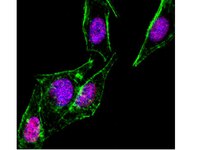05-1459 Sigma-AldrichAnti-SMAD1 Antibody, clone AS22
Anti-SMAD1 Antibody, clone AS22 detects level of SMAD1 & has been published & validated for use in WB & IF.
More>> Anti-SMAD1 Antibody, clone AS22 detects level of SMAD1 & has been published & validated for use in WB & IF. Less<<Recommended Products
Overview
| Replacement Information |
|---|
Key Spec Table
| Species Reactivity | Key Applications | Host | Format | Antibody Type |
|---|---|---|---|---|
| H, M | WB, IF | M | Purified | Monoclonal Antibody |
| References |
|---|
| Product Information | |
|---|---|
| Format | Purified |
| HS Code | 3002 15 90 |
| Presentation | Purified mouse monoclonal in 0.1M Tris-Glycine (pH7.4), 150mM NaCl with 0.05% NaN3. |
| Quality Level | MQ100 |
| Physicochemical Information |
|---|
| Dimensions |
|---|
| Materials Information |
|---|
| Toxicological Information |
|---|
| Safety Information according to GHS |
|---|
| Safety Information |
|---|
| Packaging Information | |
|---|---|
| Material Size | 200 µg |
| Transport Information |
|---|
| Supplemental Information |
|---|
| Specifications |
|---|
| Global Trade Item Number | |
|---|---|
| Catalogue Number | GTIN |
| 05-1459 | 04053252282690 |
Documentation
Anti-SMAD1 Antibody, clone AS22 SDS
| Title |
|---|
Anti-SMAD1 Antibody, clone AS22 Certificates of Analysis
| Title | Lot Number |
|---|---|
| Anti-SMAD1, clone AS22 - 2007686 | 2007686 |
| Anti-SMAD1, clone AS22 - 2279259 | 2279259 |
| Anti-SMAD1, clone AS22 - 3259069 | 3259069 |
| Anti-SMAD1, clone AS22 - 4108259 | 4108259 |
| Anti-SMAD1, clone AS22 - DAM1605006 | DAM1605006 |
| Anti-SMAD1, clone AS22 - DAM1616394 | DAM1616394 |
| Anti-SMAD1, clone AS22 - NG1548165 | NG1548165 |
| Anti-SMAD1, clone AS22 - NG1862037 | NG1862037 |
| Anti-SMAD1, clone AS22 -2632491 | 2632491 |
| Anti-SMAD1, clone AS22 -2700786 | 2700786 |















